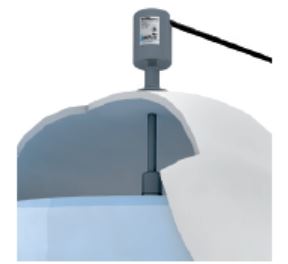Pages upon pages of information could be devoted to exploring the various products and technologies used for liquid level sensing and monitoring. But we’re not going to do that in this article. Instead, as a starting point, we’re going to provide a brief overview of the concepts of discrete (or point) level detection and continuous position sensing.
Discrete (or Point) Level Detection

In many applications, the level in a tank or vessel doesn’t need to be absolutely known. Instead, we just need to be able to determine if the level inside the tank is here or there. Is it nearly full, or is it nearly empty? When it’s nearly full, STOP the pump that pumps more liquid into the tank. When it’s nearly empty, START the pump that pumps liquid into the tank.
This is discrete, or point, level detection. Products and technologies used for point level detection are varied and diverse, but typical technologies include, capacitive, optical, and magnetic sensors. These sensors could live inside the tank outside the tank. Each of these technologies has its own strengths and weaknesses, depending on the specific application requirements. Again, that’s a topic for another day.
In practice, there may be more than just two (empty and full) detection points. Additional point detection sensors could be used, for example, to detect ¼ full, ½ full, ¾ full, etc. But at some point, adding more detection points stops making sense. This is where continuous level sensing comes into play.
Continuous Level Sensing

If more precise information about level in the tank is needed, sensors that provide precise, continuous feedback – from empty to full, and everywhere in between – can be used. This is continuous level sensing.
In some cases, not only does the level need to be known continuously, but it needs to be known with extremely high precision, as is the case with many dispensing applications. In these applications, the changing level in the tank corresponds to the amount of liquid pumped out of the tank, which needs to be precisely measured.
Again, various technologies and form factors are employed for continuous level sensing applications. Commonly-used continuous position sensing technologies include ultrasonic, sonic, and magnetostrictive. The correct technology is the one that satisfies the application requirements, including form factor, whether it can be inside the tank, and what level of precision is needed.
At the end of the day, every application is different, but there is most likely a sensor that’s up for the task.


2 Replies to “Liquid Level Sensing: Detect or Monitor?”